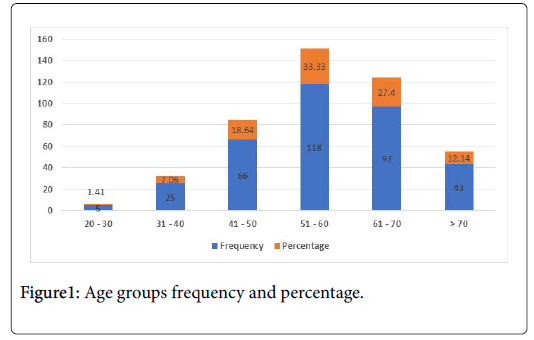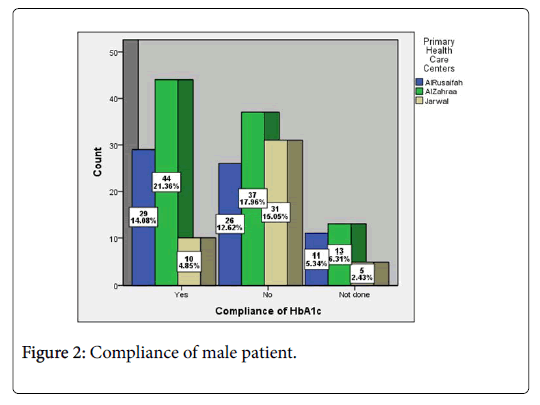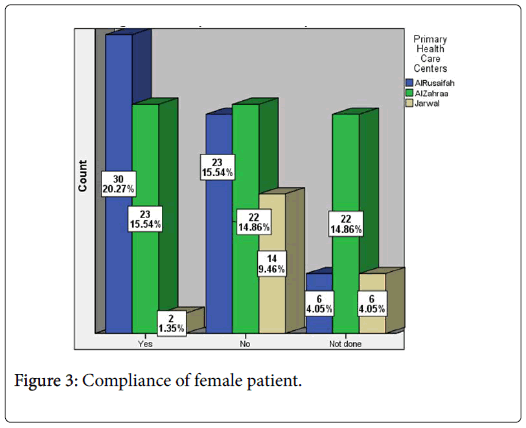Compliance of Hba1c Test in Three Selected MOH Primary Health Care Centers of Makkah
Received: 20-Nov-2017 / Accepted Date: 06-Dec-2017 / Published Date: 11-Dec-2017 DOI: 10.4172/2161-0711.1000571
Abstract
Objectives: The aim of this study was to determine the compliance of HbA1c Test in registered diabetic patients of three selected PHC Centers of Makkah.
Methods: We conducted a retrospective review of medical records of registered Saudi patients with type 2 diabetes to know the compliance of HbA1c in three randomly selected MOH PHC Centers. Sample size calculated was 354 patients with confidence level of 95% and confidence interval of 5. Data was processed on Microsoft Excel and SPSS-23 software.
Results: Overall the age range was 21-79 (58) years and a mean of +/- SD of 56.67 +/- 11.97.Hb A1C test was done in 292 (82.48%) patients. Overall PHCs HbA1c compliance rate was 38.9%. The compliance at PHC Rusaifah, Zahraa and Jarwal was 47.5%, 41.3% and 17.6% respectively (p<0.001).
Conclusion: Very low compliance rate of HbA1c test in Primary Health Centers indicate non seriousness in our study group.
Keywords: HbA1c test; Compliance; Diabetes type 2 patients; PHC centers
Introduction
Diabetes is one of the largest global health emergencies of the 21st century. According to the World Health Organization (WHO) estimates, high blood glucose is the third highest risk factor for premature mortality, after high blood pressure and tobacco use [1]. Diabetes diagnostic criteria revolve around hyperglycemia therefore diabetes diagnostic tests focus on establishing increase in blood glucose [2]. Currently diabetes is tested by random/casual blood sugar test, fasting blood sugar (FBS) or an OGTT of 75 gm, and HbA1c. Most reliable methods are FBS and HbA1c. However HbA1c is now considered as the gold standard for assessment of glycemic control [3]. Since March 2009 World Health Organization is recommending the use of HbA1c as a diagnostic test with a cut point of 6.5% for diabetes [3,4].
The HbA1c test is a blood test that measures the average blood glucose level over the previous 3 to 6 months by measuring the level of glycated hemoglobin, the oxygen transporting protein found in red blood cells [3]. Rahbar in 1968 first time discovered that HbA1c is elevated in people with diabetes. Later on WHO mentioned [5], the test as an alternative test to be used for diabetes diagnosis, based on various research studies published in American journals of epidemiology in 1984. By the 1990s, strong evidence from two large scale studies, the Diabetes Control and Complications Trial (DCCT) [6] and the United Kingdom Prospective Diabetes Study (UKPDS) [7], demonstrated the usefulness of HbA1c. These studies demonstrated that improving HbA1c by 1% (or 11 mmol/mol) for people with diabetes cuts the risk of micro vascular complications by 25% [8].
Globally the prevalence is observed in age group 20-79. The greatest number of diabetic patients belong to 20-64 (77.28%) [9]. According to International Diabetic Federation(IDF) estimates, Saudi Arabia currently with 24% prevalence, occupy seventh position in global prevalence, which is expected to rise 24.5% by the year 2035 [10]. The existing situation is very gloomy and it has been estimated that by 2040 diabetic people number will rise to 72.1 million. According to IDF Saudi Arabia country report, the number of cases of diabetes in adults that are undiagnosed (1000s) are 1,244.3 [11].
MOH (Ministry of Health) Saudi Arabia aims to advance the health system and make the quality level of the health services delivered by the MOH live up to the quality levels possessed by the developed countries [12]. Extensive investment cum tremendous improvements in health care systems in a short time has put Saudi Arabia on top 26 country even better than USA, Canada, Australia and New Zealand in World Health Organization Ranking; The World’s Health Systems [13,14]. MOH Saudi Arabia in 2011 started the Diabetes Prevention and Control Program with establishing 20 diabetes centers all over the kingdom to provide educational, medical and support services to all diabetic individuals [15]. A huge cost per person with diabetes in Saudi Arabia is estimated as 1,145.3 US Dollar [11].
At present in Primary Health Care Centers a regimen of monthly consultations of diabetic patients with doctors at primary health care centers is being followed up. For this purposes files of the patients along with their complete essential data are maintained at PHC of the respective area where patients reside. Statistics of the Diabetic patients of Makkah district is being maintained at public health department of Headquarters Ministry of Health. The number of registered diabetes patients in 28 primary health care centers of Makkah district by the end of year 2015 was 27399. This include 8484 diabetes and 18915 diabetes plus hypertension patients. Only Saudi nationals are authorized to get free treatment at the PHCs.
Our aim/objective was to determine the compliance of HbA1c test in registered diabetic patients both male and female, only diabetes and diabetes with hypertension in three selected primary health centers (PHCs) Al-Rusaifa, Zahara and Jarwal.
Patients and Methods
This was a cross-sectional descriptive study started from 20 June 2015 to 31 December 2015. Cluster probability sampling method was adopted. Cluster of north, south, west and east sectors of Makkah region were made by dividing the area geographically. In this study, from one sector three Primary Health Care Centers (PHCs) were marked out of 28 PHCs located in Makkah city. These were Al-Rusaifa, Al-Zahra and Jarwal of Ministry of Health. The study subjects were the registered Saudi patients of diabetes mellitus and diabetes mellitus with hypertension of both genders living permanently at Makkah.
The sample size calculated for this population was 354 patients with confidence level of 95% and confidence interval 5. Sample size was distributed into following arrangement according to flow of patients in respective PHCs (Table 1). In these respective PHCs, patient’s files were selected by doing a random sampling.
| No | Name of PHC | No of patients with diabetes and hypertension | No of patients with Diabetes | Total Patients | Distribution of Sample size (n=354) |
|---|---|---|---|---|---|
| 1 | Al - Rusaifah | 368 | 536 | 904 | 124 (35%) |
| 2 | Al - Zahraa | 278 | 591 | 869 | 162 (45.76%) |
| 3 | Jarwal | 140 | 344 | 484 | 68 (19.24%) |
| Total | 786 | 1471 | 2257 | 354 (100%) | |
Table 1: Selected primary health care centers with registered diabetic patients and size of samples.
Recording of data was done as under:
• All entries of HbA1c were collected year wise.
• Data of Fasting /Random blood sugar level was not taken.
• Data was grouped in four section of <2013, 2013, 2014, and 2015.
• Minimum one entry of HbA1c was considered for recording.
• Cross tabulation of different study variables with respect to each Primary Health Care Center was done where found necessary.
• Duration between the two tests was set at 6 months.
• Only last three entries were noted within limited time.
• If at the time of collection of data, the files contain single entry of the year 2015 (whether normal or abnormal) within 06 months was labeled as valid compliance.
Selection criteria
Inclusion criteria: Type-II diabetes mellitus Saudi registered patients aged ≥ 18 years in respective primary health care centers and should be permanent resident of the holy capital Makkah al Mukarrahma.
Exclusion criteria: Registered/Unregistered Saudi patients aged <18 years of type II diabetes mellitus in respective primary health care centers and not a permanent resident of the holy capital Makkah al Mukarrahma.
Formal written permission from Director Public Health programme Directorate of Makkah ministry of health was obtained. Data was processed on Microsoft Excel and SPSS-23 software. Results were tabulated and interpretation of data was done.
Ethical considerations: Approval for the access of data of individual patients was officially granted by the directorate of Health.
Results
Overall the age range was 21-79 (58) years and a mean of +/- SD of 56.67 +/- 11.17. Maximum population was of the age group 51-60 (33.33%) years, followed by 61-70 (27.40%) years and 41-50 (18.64%) year’s age groups (Figure 1). In the sample population male were 206 (58.2%) and female 148 (41.81%). Patients were categorized in two groups of, diabetes only and diabetes with hypertension.
Available data of HbA1c was spread from 1993 to 2015 hence, fouryear wise groups of <2013, 2013, 2014 and 2015 were created. Year wise record is given in Table 2. These results were highly significant p<0.001(8 df 32.67). Total 437 entries (against 1062) of HbA1c% were found and recorded.
| PHC | Number of Patients (n) | <2013 | 2013 | 2014 | 2015 | Total Entries | Not done | Total Entries required |
|---|---|---|---|---|---|---|---|---|
| AL Rusaifa | 124 | 35 | 24 | 56 | 71 | 186 | 186 | 372 |
| Al- Zahraa | 162 | 37 | 36 | 49 | 69 | 191 | 295 | 486 |
| Jarwal | 68 | 19 | 15 | 14 | 12 | 60 | 144 | 204 |
| Total | 354 | 91 | 75 | 119 | 152 | 437 | 625 | 1062 |
Table 2: Year wise categories of HbA1c entry.
HbA1c compliance results of both genders are shown in Figures 2 and 3. Gender variation was significant p<0.05 male (df 4:11.939) and female (df 4:17.840), Total PHC compliance was highly significant p<0.001 (df 4:22.701). HbA1c compliance results of both types of diabetes are shown in Table 3. Diabetes types variation was significant p<0.05 diabetes only (df 4:12.384), diabetes with hypertension (df 4:12.167).
| Types of patients | Compliance | Primary Health Care Centers | Total | ||
|---|---|---|---|---|---|
| A1Rusaifah | A1Zahraa | Jarwal | |||
| Diabetes Only | Yes | 31 (50%) | 36 (41.8%) | 5 (20.8%) | 72 (41.8%) |
| No | 25 | 30 | 16 | 71 | |
| Not Done | 6 | 20 | 3 | 29 | |
| total | 62 | 86 | 54 | 172 | |
| Diabetes & Hypertension | Yes | 28 (45.1%) | 31 (40.7%) | 7 (15.9%) | 66 (36.2%) |
| No | 23 | 31 | 29 | 83 | |
| Not Done | 11 | 14 | 8 | 33 | |
| total | 62 | 76 | 44 | 182 | |
| Total | Yes | 59 (47.5%) | 67 (41.3%) | 12 (17.6%) | 138 (38.9%) |
| No | 48 | 61 | 45 | 154 | |
| Not Done | 17 | 34 | 11 | 62 | |
| total | 124 | 162 | 68 | 354 | |
Table 3: Compliance of HbA1c in different types of patients.
Discussions
Patient compliance of HbA1c quarterly for reviewing diabetic status is an integral part of national reference of clinical guidelines for care of diabetic patients in primary health care in Saudi Arabia. HbA1c test is advised to diabetic patients in routine. We searched the files of the diabetic patients to record at least one entry of HbA1c for checking the minimum response of patients/performance of respective PHCs. In total 292 patients’ files, out of 354 (82.48%) had entry/entries of HbA1c.
The age range chosen by International diabetic federation is 20-79 years. Our study samples have age range of 21-79 years. In age group 51-60 maximum noncompliance of HbA1c was noted. Overall PHCs HbA1c compliance rate was 38.9%. The compliance at PHC Rusaifah, Zahraa and Jarwal was 47.5%, 41.3% and 17.6% respectively (p<0.001). A study of PHCs of Makkah al Mukarrahma region in 2011 detected a 16.57% (n=320) compliance of HbA1c [16]. A study in Abha, Saudi Arabia while reviewing case notes of patients with diabetes at the primary health care centers showed that only 4% had a record of HbA1c test [17]. In a study done in Bahrain HbA1c was done twice a year in 20.5% of patients [18]. Similarly, an Ethiopian study found that none of study diabetic patients had HbA1c determination [19]. Male and female compliance significant results may be attributed to relaxed attitude of patients who adopts short cut of having lab test suitable/comfortable to them. This was also observed in a study [16] at Makkah Saudi Arabia where 10% Random blood sugar test was done in diabetic patients who avoided to have HbA1c test facility in another center.
The Kingdom of Saudi Arabia (KSA) despite of tremendous improvements in health care systems by extensive investments [13,14] still facing several health challenges that are unusual for a country with high income. There is a rising burden of non-communicable diseases including diabetes as a result of rapid changes in behaviors [20]. This can be attributed to socio-economic changes, westernization, and ageing of the population, changes in nutrition, a decrease in physical activity, and the resulting tendency towards obesity. Compliance of HbA1c for diabetic patients in primary health care centers showed a substandard result which may be attributed to lethargic attitude of diabetic patients, and medical staff. Laboratory facilities for HbA1c exists only at PHC Askan in Makkah and patient remain reluctant to proceed at this Primary Health Care Center.
Conclusion
Kingdom of Saudi Arabia is one of the countries where a wellestablished health infrastructure for diabetic care is available. Despite of free treatment at primary health care centers and consultation services at the hospitals the diagnostic diabetic care is not of the standard. This can be improved by making strategies to launch diabetic patient education Programme and improve both the structure and processes of diabetes care together with healthy behaviours of diabetic patients.
Acknowledgments
The authors gratefully thank the Assistant Director Primary Health Care Ministry of Health Makkah Al-Mukarrahma and personnel of the respective Primary Health Centers for their kind cooperation and the support.
References
- World Health Organization (2017) Diabetes. World diabetes day 2017: Women and diabetes. Geneva.
- World Health Organization (2006) Definition and diagnosis of diabetes mellitus and intermediate hyperglycemia. Report of a WHO/IDF Consultation. Geneva.
- Booz, Allen, Hamilton (2000) Exploring the growing challenge of diabetes across the GCC and within the United Arab Emirates.
- Nathan DM, Genuth S, Lachin J, Cleary P, Crofford O, et al. (1993) The effect of intensive treatment of diabetes on the development and progression of long-term complications in insulin-dependent diabetes mellitus. N Engl J Med 329: 977-986.
- UK Prospective Diabetes Study Group (1998) Intensive blood glucose control with sulphonylureas or insulin compared with conventional treatment and risk of complications in patients with type 2 diabetes (UKPDS 33). Lancet 352: 837-853
- International diabetes Federation (2017) IDF Diabetes Atlas Seventh Edition 2017.
- International diabetes Federation (2013) IDF Diabetes Atlas Sixth Edition 2013.
- International Diabetes Federation (2016) Middle east & north Africa region (MENA) country report-Saudi Arabia.
- Ministry of Health Portal (2014) A media report on the MOH's services on the occasion of the ninth allegiance anniversary. MOH Publications.
- Almalki M, Fitzgerald G, Clark M (2011) Health care system in Saudi Arabia: An overview. East Mediterr Health J 17: 784-793.
- Colliers International (2012) Kingdom of Saudi Arabia healthcare overview.
- Eiad A, Al-Faris (1997) Guidelines for the management of diabetic patients in the health centers of saudi Arabia. J Family Community Med 4: 12-23.
- Siddiqui MS, Aziz M, Ali MA (2014) Diabetic control situation: A study of diabetic patients in ministry of health primary health centers of Makkah al Mukarrahma Saudi Arabia. Professional Med J 21: 936-994.
- Alshehri A (2014) Assessment of diabetes care in Saudi Arabia: By analysis of routine healthcare data, patient case notes and interviews with key stakeholders. Student thesis: Doctoral thesis University of Dundee.
- Salman R, Bahrain (2005) Evaluation of diabetes service provision in a government health centre in Bahrain, Medical Bulletin.
- Feleke Y, Enquselassie F (2005) An assessment of the health care system for diabetes in addis Ababa, Ethiopia. Ethiop J Health Dev 19: 203-210.
- Memish ZA, Jaber S, Mokdad AH, AlMazroa MA, Murray CJ (2014) Burden of disease, injuries, and risk factors in the Kingdom of Saudi Arabia, 1990-2010. Prev Chronic Dis 11: E169.
- Memish ZA, Jaber S, Mokdad AH, AlMazroa MA, Murray CJ, et al. (2014) Burden of Disease, Injuries and Risk factors in the Kingdom of Saudi Arabia, 1990-2010, Preventing chronic disease. Public Health Research, Practice, and Policy 11: 140176.
Citation: Siddqui MS, Siddqui MK, Zakaria M, Ahmad Ali M, Band B (2017) Compliance of Hba1c Test in Three Selected MOH Primary Health Care Centers of Makkah. J Community Med Health Educ 7: 571. DOI: 10.4172/2161-0711.1000571
Copyright: ©2017 Siddqui MS, et al. This is an open-access article distributed under the terms of the Creative Commons Attribution License, which permits unrestricted use, distribution, and reproduction in any medium, provided the original author and source are credited.
Share This Article
Recommended Journals
Open Access Journals
Article Tools
Article Usage
- Total views: 6398
- [From(publication date): 0-2017 - Apr 04, 2025]
- Breakdown by view type
- HTML page views: 5582
- PDF downloads: 816



